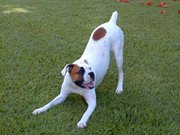 Properly socialized Dogs can interact with unfamiliar Dogs of any size and shape
and understand how to communicate.
Properly socialized Dogs can interact with unfamiliar Dogs of any size and shape
and understand how to communicate.
|
From Wikipedia the free encyclopedia, by MultiMedia |
Dog society can be thought of as Dog packs characterized by companionate hierarchy, in which each individual has a rank, and in which there is intense loyalty within the group. Dogs thrive in human society because their relationships with humans mimic their natural social patterns. The Dog is always aware of its rank relative to other individuals in the group. An assertive Dog may consider itself the alpha animal, considering its human master to be subordinate.
 Properly socialized Dogs can interact with unfamiliar Dogs of any size and shape
and understand how to communicate.
Properly socialized Dogs can interact with unfamiliar Dogs of any size and shape
and understand how to communicate.
Dogs, like wolves, establish a hierarchy through aggressive play and roughhousing along a continuum of dominance and submission. When kept as pets, Dogs include humans in this hierarchy. It is important for successful socialization that puppies participate with their littermates in learning to relate to other Dogs. Dogs learn to successfully relate to other Dogs by keeping the peace rather than constantly fighting to reestablish this hierarchy.
Dominant Dogs generally take the initiative and are more active than less dominant Dogs. Displays of dominance include standing above or over other Dogs, placing a paw on other Dogs, holding the tail and ears erect, looking directly at other Dogs, circling and sniffing other Dogs, growling if the other Dog moves, and aggressive marking of territory with urine. Submissive displays mirror dominant displays and include adopting a posture that is lower than other Dogs, such as crouching, rolling over on the back and exposing the abdomen, lowering the tail—even tucking it beneath the legs, flattening of the ears, averting the gaze, nervously licking or swallowing, dribbling of urine, and freezing or fleeing when other Dogs are encountered.
Ideally, the dominant/submissive social structure of Dogs avoids conflict and enforces social stability. Poorly socialized Dogs who are inept at establishing dominance hierarchy may become involved in excess conflicts, especially from a human viewpoint. People who misunderstand Dog behavior or who have inadvertently placed themselves in a disadvantageous position within the dominance submissive hierarchy can find themselves participants in similar conflicts with the animal(s).
It is problematic to anthropomorphize the dominance/submission behavior of a pet or to mistake it for characteristics more appropriately applied to humans. It can be dangerous for a Dog to be dominant relative to its master or mistress. By rewarding "bravery" or "boldness", there is a risk that in fulfilling a Dog's wants it begins to feel it is the dominant pack member. Likewise, it can be dangerous for a Dog to consider itself "the equal of any Dog", because unnecessary and destructive conflict can result; rewarding a Dog's aggressive behavior may eventually backfire. Likewise, submission in a Dog is not necessarily an indication of a problem Dog. Continuing to discipline a Dog after it has adopted a submissive posture is contrary to a goal of obedience. From the Dog's viewpoint, it has conceded the point and is communicating its acceptance of the owner's dominance.
 Dog language can generally be learned by humans; this Dog is inviting play.
Dog language can generally be learned by humans; this Dog is inviting play.
Dogs value the companionship of the others in their "pack" and are sometimes distressed if they are separated from it. Typical reactions when a Dog is separated from the pack are barking, howling, digging, and chewing. These activities may distress humans when they need to leave Dogs alone for a period of time. However, this behavior, called separation anxiety, can be overcome with training, or at least decreased to the point where it becomes manageable. If young puppies are habituated to periods alone from an early age, this can normally be prevented entirely. Some owners struggling to deal with this problem resort to debarking.
Dogs enjoy spending time with and interacting with other Dogs. Roughhousing and chasing one another are favorite activities. Off-leash Dog parks can be good places for Dogs to exercise and interact with other Dogs. When seeking relaxation, Dogs enjoy lying about with their companions, favoring spots with a good view of their surroundings.
Dogs, made by MultiMedia | Free content and software
This guide is licensed under the GNU Free Documentation License. It uses material from the Wikipedia.